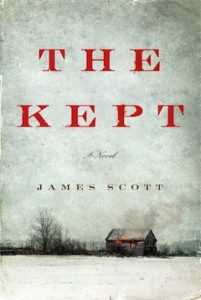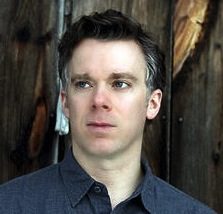
Set in the barren, mid-winter landscape of western New York during the year 1897, James Scott’s debut novel doesn’t wait around to get the plot rolling. The opening of The Kept follows Elspeth Howell, a traveling midwife, as she returns to her family’s homestead after a few months of delivering children in the nearby towns. Two pages into the book, she finds her daughter’s corpse buried in a snowdrift outside the entrance of their home, the girl coated in the “obsidian mass” of her own frozen blood. Once Elspeth goes inside, the scene unspools still more horrifyingly. Room by room, she finds the rest of her kin similarly butchered.
The only one left alive is her youngest son, Caleb, a twelve-year-old who serves as the second protagonist of the novel. When we shift to his point of view soon after Elspeth’s arrival, we learn that three nameless men attacked the family several days before, a massacre Caleb only survived due to his idiosyncratic habit of sleeping in the barn with the livestock. There are a few more inventive turns of the plot in this opening section that I won’t give away. But it’s safe to say that these events establish the premise. After some deliberation, Elspeth and Caleb decide to track down their assailants and kill them, a difficult task considering their only clue is that all three men wore red scarves.
Although the material is bracingly grotesque, The Kept has a current of artistry running beneath. Scott’s technique is to interlace the macabre with lyrical images, an approach that has two effects. The first is that we are simultaneously horrified and captivated by the events. The second is that we never become fully inured to their savagery. Instead, each eruption of violence retains its poignancy, the unique vividness of a lived experience. Consider the following example: Before leaving on their hunt, Caleb decides to burn his dead relatives in a funeral pyre, only to accidentally ignite the family home when the wind changes course, redirecting the flames along a tributary of spilled kerosene. As the house becomes an inferno, a pair of owls burst forth from the attic, one of them unlucky enough to have its feathers set alight by the blaze. It flaps furiously through the night sky until the flames consume it, at which point it plunges to the snow-covered earth with a hiss. The book is filled with such moments. Half beautiful, half disturbing, they decorate The Kept like frescoes in a crumbling cathedral.
The novel’s brutal opening and its usage of three apparently motiveless killers brings Cormac McCarthy to mind. Any time an implacably evil gunman appears these days, it’s hard not to think of Anton Chigurh, the assassin-cum-serial-killer of No Country for Old Men. A more accurate McCarthy comparison might be the horsemen of Outer Dark, three quasi-supernatural murders who ride throughout the Appalachian countryside, wreaking biblical levels of destruction. But the comparison doesn’t run as deep as one might expect. McCarthy’s work insists on the universe’s fundamental inhumanity, a world with no justice, a world where amoral violence is likely to rain down at any second because—well—that’s just the way the life is. Scott’s book makes room for a lot more heart. Though brutal, it strives to explore the emotional consequences of brutality. In fact, Scott’s main concern as the novel develops is the ability of familial tenderness to assert itself even in the most harrowing circumstances. As strange as it sounds, The Kept is refreshingly empathetic.
Much of this empathy takes center stage when Elspeth and Caleb arrive at the town of Watersbridge, a grubby, lawless outpost whose main industry is cutting ice from the massive expanse of Lake Erie. At this point, the revenge narrative is turned on its head. Instead of the search-and-destroy mission we expect, we are supplied with a subtle interpersonal drama between Elspeth and Caleb. At first the pair decide to stay in Watersbridge because they believe it might be a good place to gather information and rest temporarily. Yet—against all odds—they begin to improvise a more rooted life. After disguising herself as a man and adopting her dead husband’s name, Elspeth gets a job cutting ice, building a tenuous friendship with one of the men on her crew. Meanwhile, in hopes of finding the killers, Caleb takes a job doing household chores at the Elm Inn, a brothel where the criminal element gathers.

As they live this ad-hoc life, we realize that Caleb and Elspeth are coming to know each other for the first time. Their unfamiliarity is caused partly by Elspeth’s travels as a midwife, which often took her away for extended periods. But, more meaningfully, the tenuousness of their bond stems from Elspeth’s husband Jorah, an overweening religious zealot who required her to defer to his judgement. Years of submission left Elspeth unsure of herself around her own family, rarely speaking—especially to Caleb, who never had Jorah’s full approval. Now that Jorah is dead, both Caleb and Elspeth slowly bond over the fact that neither of them felt comfortable around their devout patriarch, Caleb even admitting that he always came to dinner late in order to avoid grace. Still, though they bond through their shared lack of faith, neither can quite believe that rejecting religion is the right path. Instead, they come to accept themselves as outcasts and sinners, a state that only seems tolerable so long as they have each other.
Western New York’s brooding landscape certainly suits the mood of The Kept. However, as it turns out, the religious history of the region suits Scott’s narrative as well. Often forgotten now, western New York was an epicenter of spiritual fervor throughout the 19th century, every decade spewing up some new sect of still more radical believers—Mormons, Shakers, Millerites, spiritualists, and a number of utopian Christian communities. It seems that somebody was waking up to discover himself a prophet almost every day. In fact, one preacher famously referred to the area as the “burnt district” because the flames of revivalism had burned so intensely that the region had no remaining “fuel” (i.e. there was no one left to convert). In this atmosphere, it’s easy to imagine how alienated Caleb and Elspeth must feel.
My only quibble with The Kept is that I wish it made more use of New York’s rich history. This isn’t exactly a flaw, but it does feel like a missed opportunity. As I read, I kept wondering if more historical context might have lent additional weight and strangeness to its already compelling motifs. Instead, Scott wears history lightly, putting his characters front and center. For many readers, this may be the right choice. When it comes to period specifics, a little goes a long way. But I kept thinking that some details about New York’s spiritualists, who spoke to the dead through séances, would have fit The Kept quite perfectly.
As time in Watersbridge passes, the conflict shifts to Caleb, whose craving for revenge burns more brightly than his mother’s. He grows frustrated with the fact that their search for the killers has bogged down. Additionally, a few surprising realizations about his mother force Caleb to question their relationship, allowing Scott to weave a growing web of questions about the nature of family in general. It doesn’t bear going into detail about the second half of the novel (since it would spoil it), but I will say that the stark scene that opens The Kept comes to be painted in a far more complex light. Figures that seemed to be forces of evil are not so simply understood. At the same time, Elspeth and Caleb’s righteous search for retribution is turned uncomfortably ambiguous.
In this way—unlike McCarthy—Scott portrays all his characters on a human scale, everyone being equal parts hero and villain. As I finished The Kept, I began to feel that Scott would be better compared to Federico García Lorca. Like Lorca’s “rural trilogy,” The Kept is obsessed with the theme of motherhood, as well as how mothers are so often bereaved by the tragic cycle created by vendettas. Even the algebra of Scott’s imagery is similar to Lorca’s: Fire. Blood. Birth. Death. Scott probably didn’t have Lorca on his mind as he wrote, but it seems that both writers have arrived at the same primal well. And so The Kept often feels like the shell of a Cormac McCarthy novel filled with the intricate yearning and familial strife of a Lorca play. The more I think about it, the more impressed I am by Scott’s ability to yoke these disparate impulses. It’s a gripping combination I don’t think we’re likely to find anywhere else.




